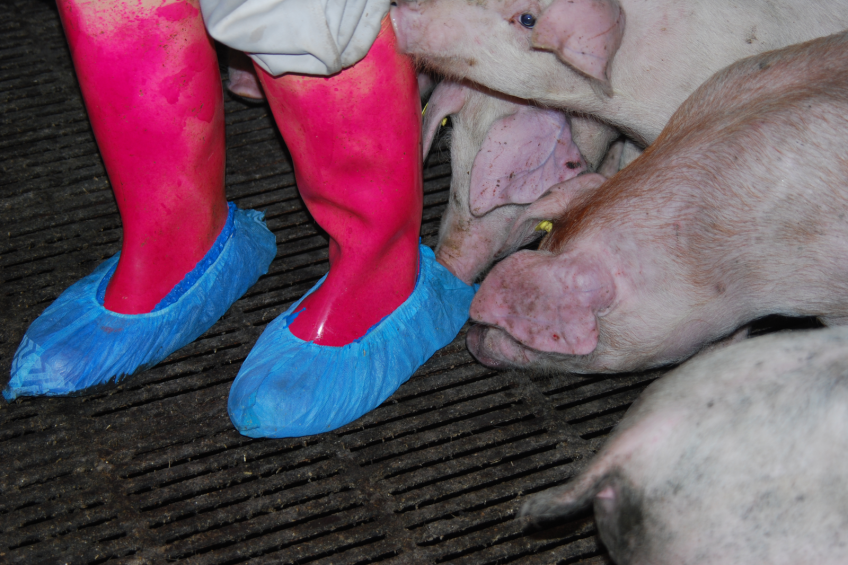Diagnosis of enteric diseases in pigs

Continued pressure on the usage of antibiotics in Denmark has led to new and quicker ways of diagnosing pig enteric diseases. A method of sock sampling might eventually lead to targeted antibiotic treatments on batch level.
In Denmark, reducing antibiotic treatments in Danish pig production has been a political aim for the past 20 years. A total ban on growth promoters was issued in 1999 which led to a situation where veterinarians only prescribe antibiotics for treatment of clinical cases of disease. As a consequence of an increased total consumption, the yellow card system was issued in 2008 – where farmers who exceed a certain level of antibiotics are penalised by the public authorities. It has resulted in more focus on reducing the antibiotic consumption, through prevention but also by reducing the number of treatment days and the dosage.
This increased focus on reduction of antibiotic consumption has led to diseases like diarrhoea and intestinal infections being quite widespread in Denmark, especially in weaners but also finisher pigs where treatments for diarrhoea and intestinal infections are the number one indication for treatment.
As a consequence, a number of research projects were started in 2008 at the University of Copenhagen, with the purpose of to improving diagnostics for intestinal infections and, in the end, improving the possibilities of treatment and reducing the antibiotic consumption for these diseases.
Lawsonia diarrhoea
It became apparent from these studies that so-called Lawsonia diarrhoea was also caused by other bacteria, including E. coli, Brachyspira species and of course Lawsonia intracellularis.
In the same period, quantitative PCR tests were developed, and these were validated in research projects in order to improve the diagnostic possibilities for each practising veterinarian. This has led to the development of what is generally known as ‘the sock method’ which consists of taking a standard sock, walking around all pens in the section to be tested, and the sock is then tested with the quantitative PCR test. The number of bacteria can be used to assess the financial impact and whether there are health-related conditions present in the animals tested.
One of the major challenges as a consequence of the reduction of antibiotics is that seven days’ treatment at certain times has been reduced to mainly clinical indication of maximum five days and in many cases down to three days’ treatment. At the same time, the dosage of antibiotics has also sometimes been reduced. Based on these changes in treatment strategies, the timing of antibiotic treatments at batch level has become extremely important. There is a very big risk of targeting pigs for antibiotic treatment at the wrong time and being either too soon or too late.
This phenomenon is known from practice, but also from research it has turned out that batches of pigs without signs of diarrhoea can still reveal a very large proportion of animals having intestinal infections. On the other hand, there are situations where there are actually outbreaks of clinical diarrhoea with no or a low occurrence of bacterial intestinal infections in the pigs that have diarrhoea. These situations include conditions as ‘unspecific colitis’ or the newly defined ‘low pathogen’ (LP) diarrhoea.
Sock sampling, pen site tests
In a present PhD study, it is considered whether sock samples and laboratory diagnostics could be used routinely as a decision tool for determining when treatment should be started in the individual batch. The first preliminary results indicate that it is possible to a certain extent, but currently this would require repeated laboratory tests in each batch of pigs, taking up a considerable amount of time and effort. There is therefore a professional reason to develop such so-called ‘pen site tests’ where farmers will be able to assess the level of pathogens on a daily basis – even in batches without any clinical signs of disease.
A complication here is that many of the pigs which might not have clinical diarrhoea still can have a severe intestinal infection. This appears in cases of Lawsonia but also E. coli or Brachyspira species. There will therefore always be a number of pigs which, although not showing signs of diarrhoea, still need antibiotic treatment as it must be assumed that they, first of all, have reduced productivity but also reduced welfare. Several studies have tried to determine if welfare has been compromised in such pigs and there are some indications that this is the case.
Treating pigs at batch level
Therefore, overall the best productivity and welfare are achieved by treating at batch level. There are consequently strong professional, scientific arguments for the fact that using batch medication in the water is actually the right thing to do.
Likewise, it has been examined if medication at pen level would be more correct, but as it turns out – all the infections are actually present at the same time in all the pens within the same room. Therefore, all pens within the same batch need treatment at the same time and nothing would be gained by medicating at pen level.
Batch medication at section level is therefore the method that provides the best result. This has also been confirmed in another research project which looked at various treatment strategies and dosages. This again showed that herd medication for five days gives the best production result.
Future developments, antibiotics in Danish pig production
Continued focus on antibiotic consumption in Danish pig production has led to a number of diagnostic and treatment-related challenges for practicing veterinarians and pig producers.
Of course, only the amount of medicine which is necessary should be used, but the exact time of treatment has turned out to be very difficult to find. There is a need for further research in this area and development of quick tests which can be used on the farms.
References available on request.











